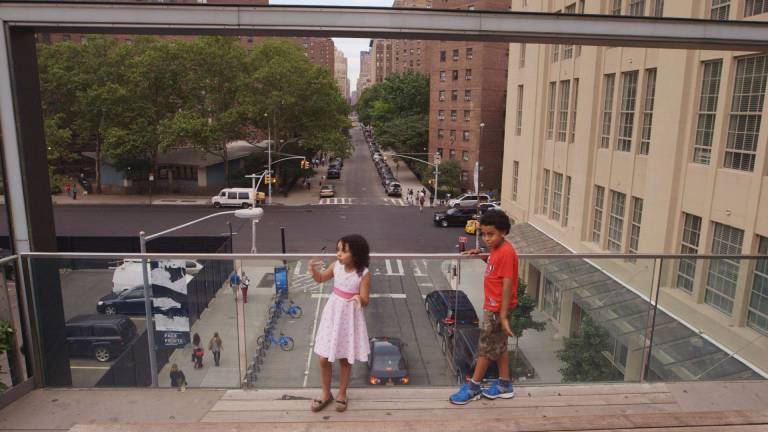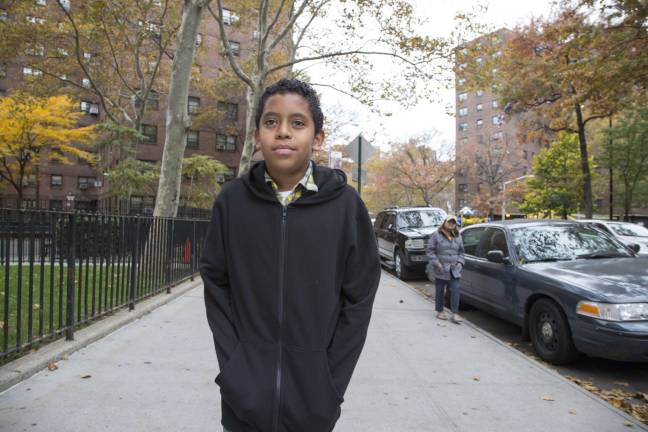chelsea, under a wide lens


Since the High Line opened in 2009, much of Chelsea has changed in untold ways. Marc Levin, a Chelsea resident for 40 years, is well-placed to explore the sometime drastic changes that have taken hold in the neighborhood. His documentary, “Class Divide,” surveys the transformation by juxtaposing the private school Avenues with the Elliot-Chelsea housing project, located across 10th Avenue. Through the eyes of children and families at both Avenues and the Elliot-Chelsea houses, the film demonstrates just how far apart two communities otherwise so close can be. “Class Divide” premieres on HBO on Monday, Oct. 3 at 8 p.m.
What got you interested in making a film about gentrification in Chelsea? I live on 26th Street so for 17 years I’ve been walking four blocks west to 601 where our studios are, and have been passing and seeing the changes in the neighborhood. When I moved in – I guess you could say I might be considered an urban pioneer -- there was still a garment factory in my building, no heat on the weekends. By the late ’80s and early ’90s I guess you could say I was becoming a part of the so-called creative class that was gentrifying parts of Chelsea.
I’ve been walking daily back and forth and it’s amazing. Somewhere after 9/11 and around 2004 or 2005 the zoning changed and Friends of the High Line started, you started really seeing an acceleration in the changes that had been happening. [Co-producer Daphne Pinkerson and I] were sitting on the High Line one day watching all the tourists take photos. Daphne and I looked at each other like, “Do they realize what’s in the background? What’s in the frame?” It was like a lightbulb went off.
How did you decide to compare Avenues: The World School with the Elliot-Chelsea houses? Inequality was an issue, obviously, that was getting more and more intense. Here you had, right on a street corner, this juxtaposition of low-income young people and kids from privilege and wealth, and you had -- with the High Line as the spine of the neighborhood -- this explosion of global wealth coming in. So it was all literally kind of a microcosm not just of New York or Manhattan but what’s going on in cities all over the country and the world. And, of course, the kids are fresh. They’re not burdened by all the political baggage and arguments. So you get this fresh perspective.
Halfway through the film it is revealed that Luc Hawkins, one of the Avenues students you interviewed, committed suicide in 2014. Why did you choose to include him anyway?That was a difficult decision and one that there was a lot of passionate discussion about. I wanted it in the film because I guess I felt that this is part of the life of the young people who knew him. This is, sadly, part of their coming-of-age, just like the kids across the street [at Elliot-Chelsea] had lost a friend in a shooting. To leave it out, I just didn’t think it was appropriate.
We had the premiere last year and Luc’s mother reached out and said she wanted to come. Afterwards there was a reception and she just came up to me and said “Marc, thank you for immortalizing my son.” So that was kind of a tremendous relief. We were totally shocked and stunned.
As a self-described gentrifier, how did making this documentary change your perspective on your own neighborhood? The way I was able to present myself was, you know, I’m a neighbor, I live here, I work here, I raised my kids here. At one point I was considered an urban pioneer, then I was looked at as a gentrifier, now I’m potentially one of the displaced. That’s the final part of the timeline. I’ve got a few years left but it’s coming to an end because there’s no way I can afford to keep my studio. I was able to present honestly to the people, the families, the school administrators, that I’ve seen it from all perspectives. Some of the changes are for the better, some are for the worse.
What do you hope viewers get out of your film besides an increased awareness of socioeconomic inequality in Chelsea? A more equal society of equal opportunity is good for everybody, it’s not just good for poor people. I think you see, when you see these kids, you see that these kids of privilege don’t want to grow up in a gilded cage where they have to be helicoptered to school. Nobody wants that. So it’s not just the kids with less means. It’s harder for a poor kid in America to move into the middle class than it is for kids in Canada, kids in Western Europe. That’s stunning. If you can’t start talking about it, if you can’t break through that, then we’re doomed. That’s not the answer, but it’s a first step.
This interview has been edited and condensed.
Madeleine Thompson can be reached at newsreporter@strausnews.com